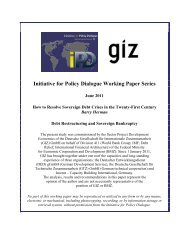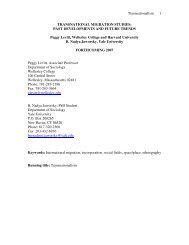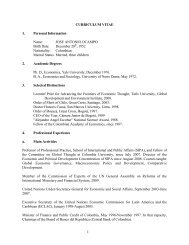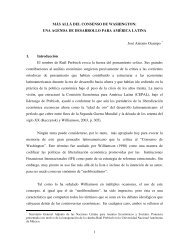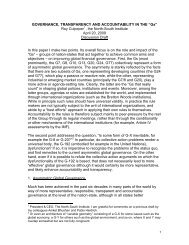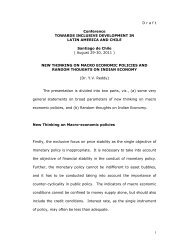Paper - Initiative for Policy Dialogue
Paper - Initiative for Policy Dialogue
Paper - Initiative for Policy Dialogue
You also want an ePaper? Increase the reach of your titles
YUMPU automatically turns print PDFs into web optimized ePapers that Google loves.
30<br />
Thus, a recurring theme of the critics of trade policies aimed at promoting<br />
development is that they created rents. Some of the trade distortions failed to promote<br />
dynamic industries. Trade re<strong>for</strong>ms in Africa often took away such distortions, but<br />
replaced them with nothing. The result was not an elimination of rents but their diversion<br />
to other less useful or “growth-unfriendly” <strong>for</strong>ms such as kickbacks on government<br />
contracts.<br />
The consequences of abjuring of any <strong>for</strong>m or degree of LIT policy proved disastrous:<br />
they were reflected in the de-industrialization of Africa, manifested in the falling share of<br />
manufacturing in GDP that has been widespread over the past two decades or so.<br />
Concomitantly, <strong>for</strong>mal sector employment has fallen as a share of total employment,<br />
often quite sharply in the face of rapid population and labor <strong>for</strong>ce growth (see the<br />
contribution of Aziz Khan). Moreover, rents are not exclusive to industrial policy or<br />
interventionism. Neo-liberal re<strong>for</strong>ms -- and especially privatizations and concessions--<br />
also give rise to rents. The issue was not whether or not there were rents but how those<br />
rents are used or what activities do they encourage; and what institutional arrangements<br />
minimized agency costs. Markets are not “technology-friendly” (<strong>for</strong> one thing<br />
technology is a public good) and rents are essential <strong>for</strong> the acquisition or development of<br />
technology.<br />
A more nuanced policy would have asked: How does one prevent the associated<br />
rents from becoming a permanent subsidy to inefficient, uncompetitive enterprises, which<br />
become addicted to the rents rather than grow-up<br />
By the same token, questions are often raised about the ability of governments to do a<br />
better job than the private sector in picking winners; but this way of putting the argument<br />
misses the point: the reason <strong>for</strong> government involvement is because of the externalities<br />
and/or other market failures. The case <strong>for</strong> government intervention is to support<br />
investment projects with large spillovers, which the private sector would not take into<br />
account in their investment decisions. (Wade makes a distinction between the state<br />
acting as a “leader” and trying to pick winners and as a “follower” that seeks to<br />
encourage nascent activities that have shown promise.)<br />
Some success cases<br />
These questions in<strong>for</strong>m the discussion “industrial policy” that is the center of<br />
attention of several of the papers in this volume Ohno and Ohno well as Hanatani and<br />
Watanabe aim to draw lessons from East Asia <strong>for</strong> Africa. They both emphasize the<br />
diversity of circumstances and LIT policies in East Asia and emphasize there is no onesize-fits-all<br />
LIT policy. A large part of the East Asian lesson is the method of policy<br />
<strong>for</strong>mulation rather than specific measures. This style of policy making is characterized by<br />
pragmatism and flexibility. As Ohno and Ohno note in such an approach, “the problem of<br />
weak policy capacity is overcome through focused hand-on endeavor to achieve concrete<br />
results, which we call dynamic capacity development, rather than trying to improve




